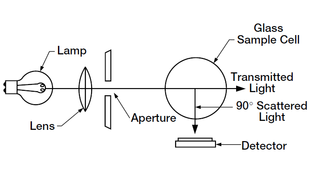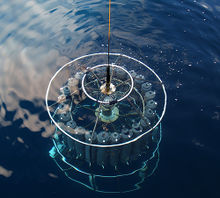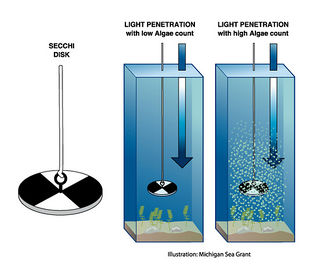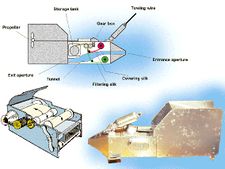Difference between revisions of "In situ monitoring of eutrophication"
(→Expendable bathythermograph) |
|||
| Line 9: | Line 9: | ||
====Expendable bathythermograph==== | ====Expendable bathythermograph==== | ||
| − | The e'''X'''pendable '''B'''athy'''T'''hermograph (XBT) is a free-fall temperature probe providing a profile of measured '''temperature''' against '''depth''' calculated from a fall-rate model (not by measuring pressure). The XBT is dropped from a ship and measures the temperature (thermistor) as it falls through the water. Two very small copper wires transmit the temperature data to the ship. The | + | The e'''X'''pendable '''B'''athy'''T'''hermograph (XBT) is a free-fall temperature probe providing a profile of measured '''temperature''' against '''depth''' calculated from a fall-rate model (not by measuring pressure). The XBT is dropped from a ship and measures the temperature (thermistor) as it falls through the water. Two very small copper wires transmit the temperature data to the ship. The depth is calculated from the elapsed time and the expected fall rate. By plotting temperature as a function of depth, scientists obtain a temperature profile of the ocean. |
| + | |||
====Thermosalinograph==== | ====Thermosalinograph==== | ||
====Secchi disk==== | ====Secchi disk==== | ||
Revision as of 10:03, 22 November 2013
Contents
Introduction
In situ monitoring is the observation and / or measurement of events in its original place (Latin: situs). Oceanographic instruments containing different types of sensors are used to monitor eutrophication in coastal waters. Sensors detect and respond to electrical or optical signals and convert the physical, chemical or biological parameter into a signal which can be measured electrically.
Oceanographic instruments
In this section we focus only on the instruments that measure parameters that are important in the frame of the OSPAR Eutrophication Monitoring Programme: [1]
CTD
The CTD[2][3] - Conductivity, Temperature and Depth - is the standard oceanographic tool for continuously measurement of physical properties of sea water. The instrument contains a cluster of sensors for measuring conductivity, temperature and depth. Depth and salinity are derived from measurements of pressure and electrical conductivity. The CTD is mostly attached to a frame with water-collecting Niskin bottles (CTD rosette). From the deck the rosette is lowered on a cable down to the seafloor and once in the water data are transferred via a conducting cable connecting the CTD to a computer on a ship. The Niskin bottles are closed at predefined depths to target water samples for further analysis. Other sensors to measure chemical or biological parameters such as dissolved oxygen, chlorophyll fluorescence (phytoplankton concentrations) and water light transmission can be added to the cluster.
Expendable bathythermograph
The eXpendable BathyThermograph (XBT) is a free-fall temperature probe providing a profile of measured temperature against depth calculated from a fall-rate model (not by measuring pressure). The XBT is dropped from a ship and measures the temperature (thermistor) as it falls through the water. Two very small copper wires transmit the temperature data to the ship. The depth is calculated from the elapsed time and the expected fall rate. By plotting temperature as a function of depth, scientists obtain a temperature profile of the ocean.
Thermosalinograph
Secchi disk
A common simple and cheap device for measuring ocean turbidity is the Secchi disk which consists of a circular disk (20-30 cm in diameter). The disc is being lowered into the water and the depth at which the disc is no longer visible, is a measure of the clarity of the water and is known as the Secchi depth and is related to water turbidity. The Secchi disk readings do not provide an exact measure of transparency (for example: interpretation of different observers) and are often replaced by the use of turbidity sensors (see lower).
Continuous Plankton Recorder[4]
The Continuous Plankton Recorder (CPR) is an instrument used to sample and to continuously collect plankton over a long distance at a depth of approximately 10 meters. Water passes through the CPR and plankton are filtered onto a slow-moving band of silk (270 micron mesh size) and covered by a second silk. The silk and plankton are then spooled into a storage tank containing formalin. The silk is divided into samples representing 10 nautical miles of tow. Analysis is done in two ways:
- Determination of the Phytoplankton Colour Index (PCI): the PCI is an in situ measure of ocean colour and a semi quantitative estimate of phytoplankton biomass. The colour of the silk is evaluated against a standard colour chart and given a 'green-ness' value based on the visual discoloration of the CPR silk produced by green chlorophyll pigments.
- Microscopic analysis: individual phytoplankton and zooplankton taxa are identified and counted.
Sensors
In this section we focus only on the sensors that measure parameters that are important in the frame of the OSPAR Eutrophication Monitoring Programme: [5]
Temperature
The simplest mechanical way to measure temperature is by using a mercury-in-glass thermometer. They are commonly used to measure sea surface temperature by placing it in a bucket of sea water. Electrical temperature sensors such as the Resistance Temperature Detectors (RTDs) and the thermistors are more frequently used on a CTD. A thermistor is a type of resistor composed of a small piece of electrically semiconductor material (metallic oxides) such as a resistor which exhibits a large change in resistance proportional to a small change in temperature (negative temperature coefficient). RTDs are sensors used to measure temperature by correlating the resistance of the RTD element (pure metals usually platinum) with temperature (positive temperature coefficient).
Salinity
Salinity is a measure of the quantity of salt in a volume of sea water and can be measured in situ using a conductivity sensor on a CTD. The sensor measures the electrical conductivity (electrical current: ions in solution that flow through the sea water (dissolved salts conduct more electricity than water without salts)) at a known temperature and pressure and this conductivity is converted to salinity using a formula.
Turbidity
Turbidity is a measure of water clarity or transparency caused by suspended particles from organic (algae, plankton) or inorganic (fine silts or clays) origin. The more turbid the water the less light is transmitted. Turbidity sensors designed for extended in situ measurements are based on nephelometric or optical-backscatter principles where the scattering and absorbing effects of the suspended particles on light are measured. Nephelometers measure the concentration of suspended particles in a liquid by employing a light beam 90 degrees from the light detector. Particle density is then a function of the light reflected into the detector from the particles. Optical-backscatter sensors (OBS) measure the same properties as nephelometers but the angle between the light source and the detector is less than 90 degrees.

More information
- Temperature sensors
- Salinity sensors
- Turbidity sensors
- Optical backscatter point sensor (OBS)
- Continuous Plankton Recorder (CPR)
See also
References
- ↑ OSPAR Commission (2005), Agreement on the Eutrophication Monitoring Programme (Reference Number: 2005-4)[1]
- ↑ http://www.whoi.edu/instruments/viewInstrument.do?id=1003[2]
- ↑ http://noc.ac.uk/research-at-sea/nmfss/nmep/ctd[3]
- ↑ CPR sampling: the technical background, materials and methods, consistency and comparability Batten, S.D.; Clark, R.; Flinkman, J.; Hays, G.; John, E.; John, A.W.G.; Jonas, T.; Lindley, J.A.; Stevens, D.P.; Walne, A. (2003) . Progress in Oceanography 58(2-4): 193-215.
- ↑ OSPAR Commission (2005), Agreement on the Eutrophication Monitoring Programme (Reference Number: 2005-4)[4]
- ↑ TURBIDITY SCIENCE, Technical Information Series—Booklet No. 11, Michael J. Sadar
Please note that others may also have edited the contents of this article.
|



